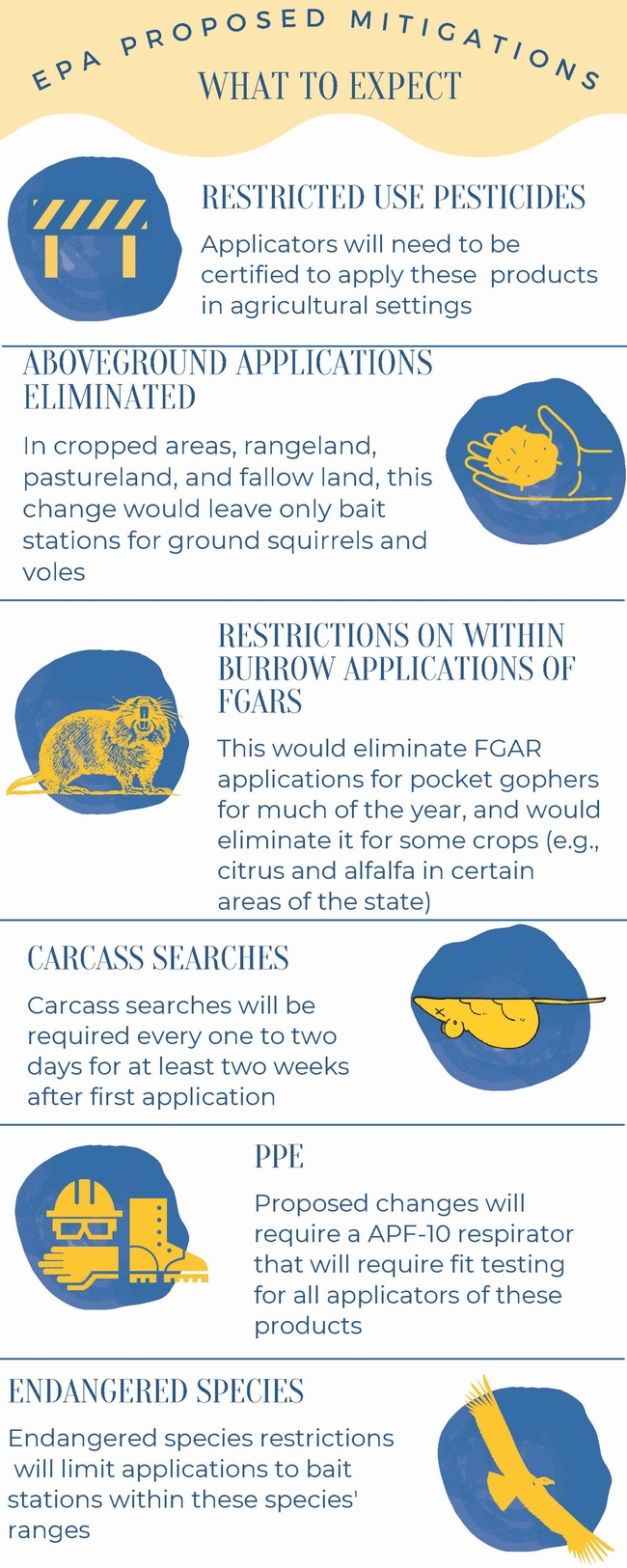U.S. EPA proposed changes to rodenticide labels for agricultural use:
opportunity for public comment
Roger A. Baldwin, Professor of Cooperative Extension, UC Davis
Niamh Quinn, Cooperative Extension Advisor, UC South Coast Research and Extension Center
Rodents cause substantial damage and health risks in agricultural productions systems through direct consumption of fruit, nuts, and vegetative material; damage to the plant (e.g., girdling of stems and trunks); by providing a food safety hazard from contamination; damage to irrigation infrastructure; damage to farm equipment; burrow systems posing a hazard to farm laborers; posing a health risk through potential disease transmission; and increased soil erosion by water channeling down burrow systems, among other potential damage outcomes. They also cause substantial damage and food contamination risks in livestock holding facilities, food processing facilities, barns, and other agricultural-related structures. As such, effective management is needed to minimize these risks. The use of rodenticides is often considered the most efficacious and cost-effective tool for managing rodent pests, and as such, it is often included in Integrated Pest Management (IPM) programs designed to mitigate rodent damage and health risks. Given the significance of rodenticides in managing rodent pests, it is important to know that the U.S. EPA has recently released a list of Proposed Interim Decisions (PIDs) for public comment that, if approved, will substantially alter if and how rodenticides may be used to manage rodent pests in the near future. As such, we felt it was important to inform California's agricultural producers as to the extent of these proposed changes, and if you are so inclined, we have provided a link for you to provide public comment on the PIDs, as well as links to contact your Senate and Congressional representatives to ensure your opinion is heard.
All rodenticides are currently under review. These include first-generation anticoagulants (FGARs; chlorophacinone, diphacinone, and warfarin), second-generation anticoagulants (SGARs; brodifacoum, bromadiolone, difethialone, and difenacoum), zinc phosphide, strychnine, bromethalin, and cholecalciferol. Of these, only FGARs, zinc phosphide, and strychnine have labels for use against field rodents (e.g., ground squirrels, pocket gophers, voles, rats, and mice found in agricultural fields), but not all of these active ingredients can be used for all rodent species. As always, it is imperative to fully read a rodenticide's label before determining if it is appropriate for use against a particular species and in a specific situation. That said, the following are some significant changes that have been proposed that you should be aware of. Other potential changes have been proposed as well, so please check out the PIDs for additional details (linked at the end of this document).
- All rodenticides for field applications will become restricted-use products. This means that applicators will need to be certified to use restricted-use products in these settings. They will also have increased reporting requirements for their use.
- Aboveground applications would be eliminated in rangeland, pastureland, and fallow land. This is a substantial deviation, as many/most applications in these areas have traditionally been through broadcast applications or spot treatments. This change would leave only bait stations for ground squirrels and voles.
- Within-burrow applications of FGARs will generally not be allowed in croplands during the growing season. This would eliminate FGAR application for pocket gophers for much of the year, and would eliminate it for all uses in some crops (e.g., citrus and alfalfa in certain areas of the state).
- Carcass searches will be required every day or every two days (starting 3-4 days after the initial application), depending on the product used and where applied, for at least two weeks after the last application of the rodenticide. When carcasses are found, they must be disposed of properly. Any non-target mortalities must be reported to the U.S. EPA. Collectively, this will require a major increase in labor, potentially making rodenticide applications impractical in many settings.
- Extensive endangered species designations are anticipated that will limit or eliminate the potential to apply rodenticides. This could have large-scale impacts, although the full extent is not known at this time.
- New labels will require the use of a PF10 respirator and chemical resistant gloves during application. This is a substantial change for some rodenticide labels, requiring fit testing for all applicators, with the requirement of respirators ultimately making rodenticide application more physically challenging.
Additional details on these proposed changes can be found at the following websites:
- Anticoagulant PID: https://www.regulations.gov/document/EPA-HQ-OPP-2015-0778-0094
- Zinc phosphide PID: https://www.regulations.gov/document/EPA-HQ-OPP-2016-0140-0031
- Strychnine PID: https://www.regulations.gov/document/EPA-HQ-OPP-2015-0754-0025
- Bromethalin and cholecalciferol PID: https://www.regulations.gov/document/EPA-HQ-OPP-2016-0077-0024
As mentioned previously, these proposed changes are likely to have a substantial impact on the use of rodenticides in agricultural settings. However, these changes are currently open for public comment. If you would like to comment on these proposed changes, the required links and useful guidance can be found at the following website: https://responsiblerodenticides.org/.
You may also comment on these proposed changes to your Senate and Congressional representatives. If you are unsure who they are or how to contact them, check out: https://www.congress.gov/contact-us.
The deadline for making comments to the U.S. EPA is unfortunately short, with a final deadline of February 13, 2023. Therefore, you will need to provide your comments in short order.
